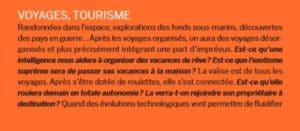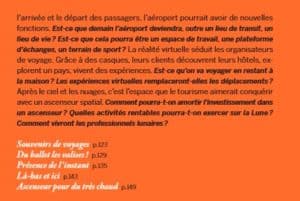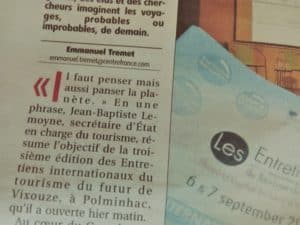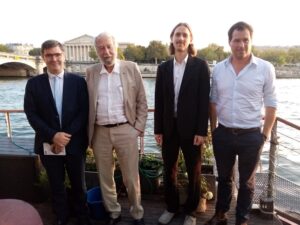💡 Reinventing tourism
💡 Reinventing tourism
At the third edition of Tourism of the Future (Les Entretiens Internationaux de Tourisme du Futur, EITF), a two-day meeting held in France on 5 and 6 September, 2018, participants gathered from around the world to explore the trends and better anticipate and prepare for 2030-2050.
Driven by shifting expectations, growing demand, dwindling resources, and mounting environmental pressures, the patterns of tourism are changing. Questions are also being raised over transport, a vital and integral part of the tourism industry that is transforming the world – not always for the better.
Air traffic figures alone are a cause for concern: a record 4.1 billion passengers took to the skies worldwide in 2017; 12 billion are expected to fly annually by 2030.

“Nothing will prevent tourism from developing,” said EITF founding president Serge Pilicer. “But it will have to reinvent itself – with a code of ethics that addresses the challenges facing humanity – to become a key contributing factor for human cohesion. Failure to meet this objective will lead to a double disaster, both sociological and ecological, come 2030-2050.”
- ‘Like any industry, tourism has winners and losers, and keeping it out of critical discussions about the direction of the economy or international debates about the environment is short-sighted.’ (Source: ‘Overbooked: The Exploding Business of Travel and Tourism’ – Elizabeth Becker, 2013)
“By 2030, I think we’ll be seeing places that can no longer support or cater for tourism, like Barcelona or Dubrovnik [which in 2017 limited the number of visitors entering the historic old town] for instance,” said Yoël Mansfeld, professor of tourism, planning & development, University of Haifa (Israel). He is convinced the only sustainable ways ahead include radical changes in mindset, a bottom up approach, educating children and adults alike, and thinking locally.
“All the international organisations like UNESCO and the UNWTO [UN World Tourism Organization] are working top-down; they create sterile policies then implement them into localities they don’t understand. Even though tourism is a global industry, we need to cater for regions and communities – what kinds of tourism will they accept, and can they cope with?”
Mr Mansfeld also insisted on avoiding the policy of “developing and developing” and on rationalising the numbers and prepare the places – “too many destinations are being over visited – we have to prepare them!”
“Over-tourism is a symptom of bad tourism management (flows and infrastructure),” said Anita Mendiratta, advisor to the secretary general, UNWTO. “Bad behaviour does the damage and this is why people [and destinations] are pushing back.”
Allowing tourism at any cost is another concern. “There must be respect and the right models – economic, cultural, social, environmental, and spiritual – for the destinations in question, and their residents.” She also warned against places selling their souls through lack of consultation at local level – “Do tourists really want to see a MacDonald’s in Reykjavík? I don’t think so.”
“Tourism is a force for good for connecting the world.” Despite the challenges, Ms Mendiratta likes to see tourism as “a vehicle for peace, as a development force for people and building global understanding that depends on synergies between local and international approaches.”
According to the 2018 edition of the ‘UNWTO Tourism Highlights’ report, international tourist arrivals (travellers arriving in different countries from their own) reached a total of 1,323 million in 2017; some 84 million more than 2016 and a new record. Available data for early 2018 has since confirmed international tourism’s continued strong growth, with a year-on-year increase of 6% in arrivals between January and April.
Spoilt kids, collapse, growth and performance
“Today we manage tourism a bit like spoilt kids, without considering its environmental and social externalities, like taxing fuel for example. But where does this leave sustainability?”
Guillaume Cromer, president of the French sustainable tourism association Acteurs du Tourisme Durable (ATD) certainly didn’t mince his words. Referencing the book ‘Collapse: How Societies Choose to Fail or Succeed’ by Jared Diamond (2005), he insisted it is high time for a new growth model that takes externalities into account.
And why not rethink the notion of performance, too? Instead of measuring it in terms of footfall, metrics such as the carbon footprint of tourism to the destination in question, or the experience of locals hosting the tourists, would surely be more meaningful from a sustainable perspective?
“Arrivals alone is the wrong metric,” added Ms Mendiratta. “Instead we should be measuring the number of jobs created and the yield tourists generate for people living in the destinations.”
Shifting models
Outlining Uber’s vision for mobility of the future, Garance Lefevre, senior policy associate at Uber France, believes the shift away from car ownership (still dominant today) will continue, sharing will grow, and a Car as a Service (CaaS) model – whereby people summon a driverless vehicle (which they don’t own) when they need to travel via a mobile app – is likely to emerge.
In anticipation of tomorrow’s mobility becoming intermodal by definition, Uber plans to position itself as a multimodal service provider to complement other transport modes, e.g. shared ride hailing (UberPool) for first/last mile journeys or even taxi drones soon. In April 2018 Uber acquired JUMP, a New-York based, electric bike-sharing start-up.
In a 2016 white paper, Uber presented uberAIR, its vision of a flying cab system – ‘to create efficient cities with less congestion and cleaner air’. Its ‘Elevate’ programme, launched the same year, has been working over the past 24 months to build a network of all-electric, vertical take-off and landing (VTOL) aircraft powered by distributed electric propulsion.
Most recently, the ride hailing giant unveiled is design models (May 2018) and announced the creation of its first research and development hub outside of North America, the Advanced Technologies Center in Paris: ‘Over the next five years, we’ll be investing €20 million into developing new technologies and capabilities to move our [Elevate] vision forward. This begins with building artificial intelligence and airspace management systems to support uberAIR at a large scale, which will be key to achieving our goal of demonstration flights in Dallas, Los Angeles, and a third, international city by 2020.’
- According to the INRIX 2017 Global Traffic Scorecard, which analysed congestion in 1, 360 cities in 38 countries, Los Angeles commuters spent over 100 hours a year in traffic jams in 2017 – more than any other city in the world. Paris ranked number nine on the list of the world’s most gridlocked cities
Car(less) ferries?
What will happen to car ferries if driverless shared cars take off and people no longer own their own vehicles? This is the unknown Christophe Mathieu, president of the executive board, Brittany Ferries, is trying to fathom out. “Our business is based on the car ferry – our ships aren’t called car ferries for nothing!”
Right now, the burning question is how cars will be used in the future and how this will impact their business model. “How should we renew the fleet [ferries are typically in service for around 30 years] given the huge investment involved?” Mr Mathieu is keen to establish a realistic vision of mobility for the decades to come.

“In the future, ferry customers may well be using autonomous ride-hailing cars to reach the terminal, then walking on and off to be picked up by the same on the other side,” In this case, should Brittany Ferries plan for carrying less vehicles and more foot passengers? (different ferry designs). Should it invest in offering fleets of vehicles at the terminals for foot passengers to drop off and pick up?
Future forward >>>
Shared mobility, intermodality, robot-taxis, electrification and more besides, smart charging, the solar highway, stations as potential energy hubs… at the EITF, members of Futura-Mobility presented trends and scenarios set to impact the way we travel – every day and as tourists – in the coming years.
Embracing renewable energies (solar, hybrid, biofuels, hydrogen) for transport can help the tourist industry reach its sustainability goals. Likewise getting existing transport infrastructure to multitask. This is the thinking behind Wattway, the highway photovoltaic technology developed by Colas (a subsidiary of Bouygues) designed to harvest solar energy and produce energy locally.
“Prior to commercialisation in 2019, in addition to testing in France, we are also putting Wattway through its paces in Japan,” said Christophe Lienard, chief innovation officer, Bouygues. 7-Eleven Inc., the Japanese–owned chain of convenience stores, has already equipped two of its car parks in Tokyo with the photovoltaic panels, and plans to cover 3,000 in total. Note: Japan purchases 96% of its energy from abroad.
Think global, act local. In the world of rail, stations may well serve as ‘power stations’ in the years to come. “We see stations as potential hubs for recovering and storing the energy dissipated when trains brake,” explained Jean-Jacques Thomas, innovation director at French rail network manager SNCF Réseau, which is already exploring this idea. “In turn, this energy would be used to power not only the stations but their surrounding district,” added Mr Thomas.

During the presentation, Joëlle Touré, delegate general, Futura-Mobility, read extracts from ‘Capsules intemporelles’, a collection of 20 short stories (in French) offering snapshots of tomorrow’s mobility imagined by Futura-Mobility founding members SNCF Réseau, Airbus, Air Liquide, Bouygues, Keolis, Safran, and Valeo, together with the writer Anne-Caroline Paucot. During a series of workshops, the heads of innovation unleashed their creativity to conjure up various scenarios and use cases.


- “To imagine these futures of mobility [with ‘Capsules intemporelles’], we wanted to step away from the linear extrapolation of our innovation programmes” – Jean-Jacques Thomas, innovation director, SNCF Réseau and president, Futura-Mobility

Space tourism – flights of fancy?
Right now, the companies battling it out to be the first to offer commercial flights into space are Virgin Galactic (Richard Branson) and Blue Origin (Jeff Bezos). “There’s a real race going on between the two,” said former US Navy test pilot and NASA astronaut Michaël Lopez Alegria, now a consultant with MLA Space.

A sub-orbital flight up to 100km from Earth is currently costed at around US$250,000 (€214,000). This kind of trip would involve a carrier plane and a rocket booster – with the plane being shot up into space then gliding back down the Earth. And then there’s a 10-day orbital flight to the International Space Station (ISS) – “a very different animal” priced from US$50 million (€43m) to US$100 million (€86m) per passenger.
Given the exorbitant cost of a ticket to ride, not to mention the fuel consumed and pollution generated, where does space tourism fit into the sustainable vision promoted by speakers at the EITF? Surely it is a rich man or woman’s folly? Remember Mr Cromer’s comment: “today, we manage tourism a bit like spoilt kids…”.
Supporters say such private initiatives will help fund space research. They also refer back to the history of aviation or the mobile phone – the original flights and handsets were hugely expensive yet are accessible for all today. So, in 2018, are we looking at the first of several generations down the line for space tourism?
Heal the planet
“We must think more carefully about the planet and also heal the planet” – Jean-Baptiste Lemoyne, French secretary of state for tourism. “Our planet has its limits!” – Guillaume Cromer, president, ATD.

Many speakers at the EITF highlighted the fragility of Earth and decried how human activities and behaviour are the root causes of its decline.
During her presentation, Sofia Stril-Rever, Sanskrit expert, writer, and co-author with the Dalai Lama, certainly drove home some uncomfortable truths. “Every 20 minutes a plant or animal species disappears; since the 1960s, 80% of the world’s animal species have disappeared.”
The wide-reaching negative impacts of our obsession with concrete make for another disturbing story. Today, the volume of concrete laid down in the world is equivalent to a 3cm-thick shell over the entire globe.

Sand with special properties (created by water erosion) is needed to make concrete, which rules out using resources from deserts. As a consequence, rivers, beaches, and sea beds have been plundered for their sand with devastating consequences: Jakarta, the capital city of Indonesia, has sunk 2.5 metres below sea level in a decade; 75% of the world’s beaches are endangered.
“Our generation will not be leaving a better world behind, and this is a first,” pointed out Ms Stril-Rever. “Measures still haven’t been taken. What can we do if even Nicolas Hulot can do nothing?”
In 1973, the Club of Rome predicted that by 2040 there would be a global collapse if expansion of the population and industry continued at current levels. Nevertheless, Ms Stril-Rever believes this risk of collapse could well prove an opportunity for transforming our current social paradigms.
The way ahead? “First, change from the inside, a revolution of consciousness; sharing, generosity, solidarity; next, change on the outside, local resilience.”
- Tourism of the Future 2017 edition – Taxidrone, Hyperloop, and Clip-Air at Vixouze



